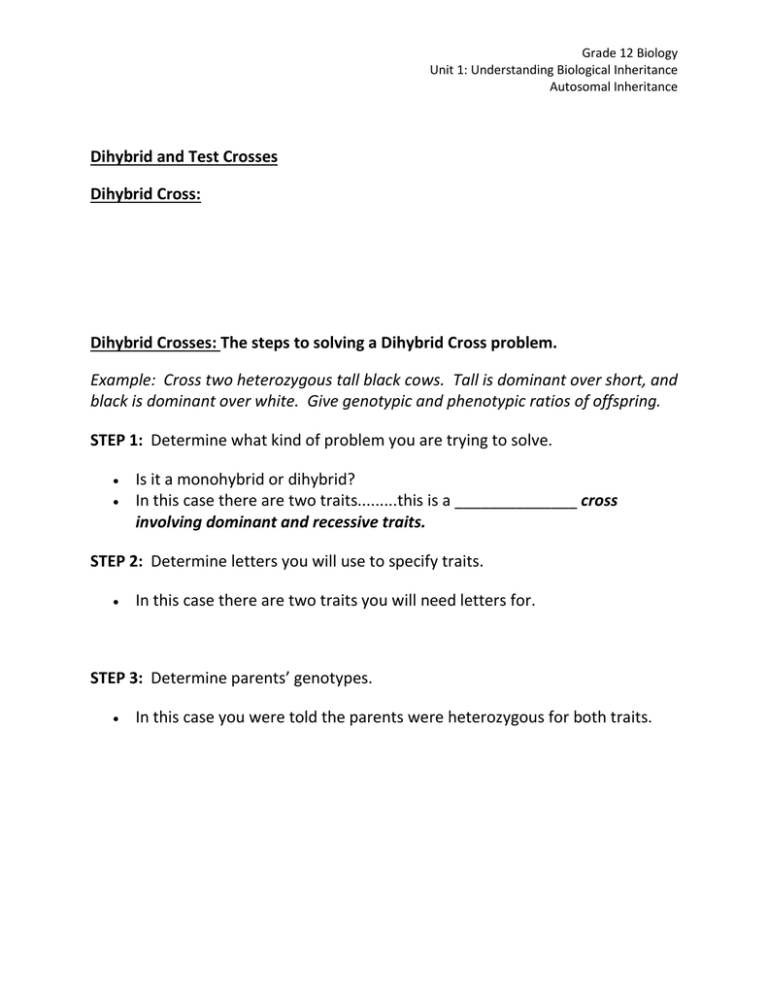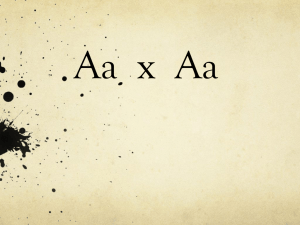File
advertisement

Grade 12 Biology Unit 1: Understanding Biological Inheritance Autosomal Inheritance Dihybrid and Test Crosses Dihybrid Cross: Dihybrid Crosses: The steps to solving a Dihybrid Cross problem. Example: Cross two heterozygous tall black cows. Tall is dominant over short, and black is dominant over white. Give genotypic and phenotypic ratios of offspring. STEP 1: Determine what kind of problem you are trying to solve. Is it a monohybrid or dihybrid? In this case there are two traits.........this is a ______________ cross involving dominant and recessive traits. STEP 2: Determine letters you will use to specify traits. In this case there are two traits you will need letters for. STEP 3: Determine parents’ genotypes. In this case you were told the parents were heterozygous for both traits. Grade 12 Biology Unit 1: Understanding Biological Inheritance Autosomal Inheritance STEP 4: Figure out the gametes possible for each of the parents. Remember, each gamete must have one copy of each gene: one B and one T allele. TtBb would make four different gametes = Make your punnet square STEP 5: Complete cross and determine possible offspring. STEP 6: Determine genotypic and phenotypic ratios. Genotypic ratio: Make a list of all the different genotypes and determine how many of each you have. The genotypic ratio would be: Phenotypic ratio: Make a list of all the different phenotypes The phenotypic ratio would be: Grade 12 Biology Unit 1: Understanding Biological Inheritance Autosomal Inheritance Test Cross: For example, a breeder wants to find out if an organism is homozygous dominant or heterozygous for a trait. Remember that the genotype can't be known by simple observation because the dominant trait will be expressed but a recessive trait may be present and not expressed. The breeder may do a test cross in which the unknown genotype is bred with an individual that is homozygous recessive for the trait. In the genotype, the unknown gene is represented by the question mark, "?". If a red pea plant is crossed with a white plant, then we express the test cross as R? x rr. According to the Law of Dominance, the unknown genotype can be RR or Rr, because both will result in red plants. If, after examining all offspring of the test cross, there are no white plants, we can assume the unknown gene "?" is R. If any offspring are white, the only way that could happen is if the unknown genotype is Rr. In this way a test cross can be used to determine an unknown genotype. Grade 12 Biology Unit 1: Understanding Biological Inheritance Autosomal Inheritance Practice Problems Complete the following genetics problems. 1. In humans, long eyelashes are dominant; short eyelashes are recessive. A woman with long eyelashes and a man with long eyelashes have four children. One child has short eyelashes; the others have long eyelashes. a) List the probable genotypes of the parents. b) List the probable genotypes of the children. 2. Peas may have yellow or green seeds. A cross between a green seed plant and a yellow seed plant (P generation) produced all yellow seeds in the F1 generation. a) Identify the genotypes of the P generation. b) What would the phenotype ratio of yellow seeds to green seeds be if one plant from the F1 was crossed with the yellow seed plant from the P generation? Grade 12 Biology Unit 1: Understanding Biological Inheritance Autosomal Inheritance 3. In cattle, polled (hornless) is dominant to horned. If a breeder of purebred cattle, all of which are polled, suspects that her recently purchased prize bull is heterozygous for the horned allele, how might she determine whether her suspicion is correct? 4. Cystic fibrosis is a recessive genetic disorder affecting 1 in every 2500 children born in Canada. A child with the disorder is born to a couple who show no symptoms of the disease. a) List the genotypes of the parents and the child. b) What is the chance that the next child the couple has will be a carrier of the disease? Grade 12 Biology Unit 1: Understanding Biological Inheritance Autosomal Inheritance 5. In rabbits, black colour is due to a dominant gene (B), and brown colour to a recessive gene (b). Short hair is due to the dominant gene (S), and long hair to its recessive allele (s). A homozygous black, long-haired rabbit and a homozygous brown, shorthaired rabbit are crossed. a) What would be the genotype of the F1 generation? b) What would be the phenotype of the F1 generation? c) If one of the F1 rabbits was mated with a brown, long-haired rabbit, predict the phenotype and genotype ratios of the offspring







